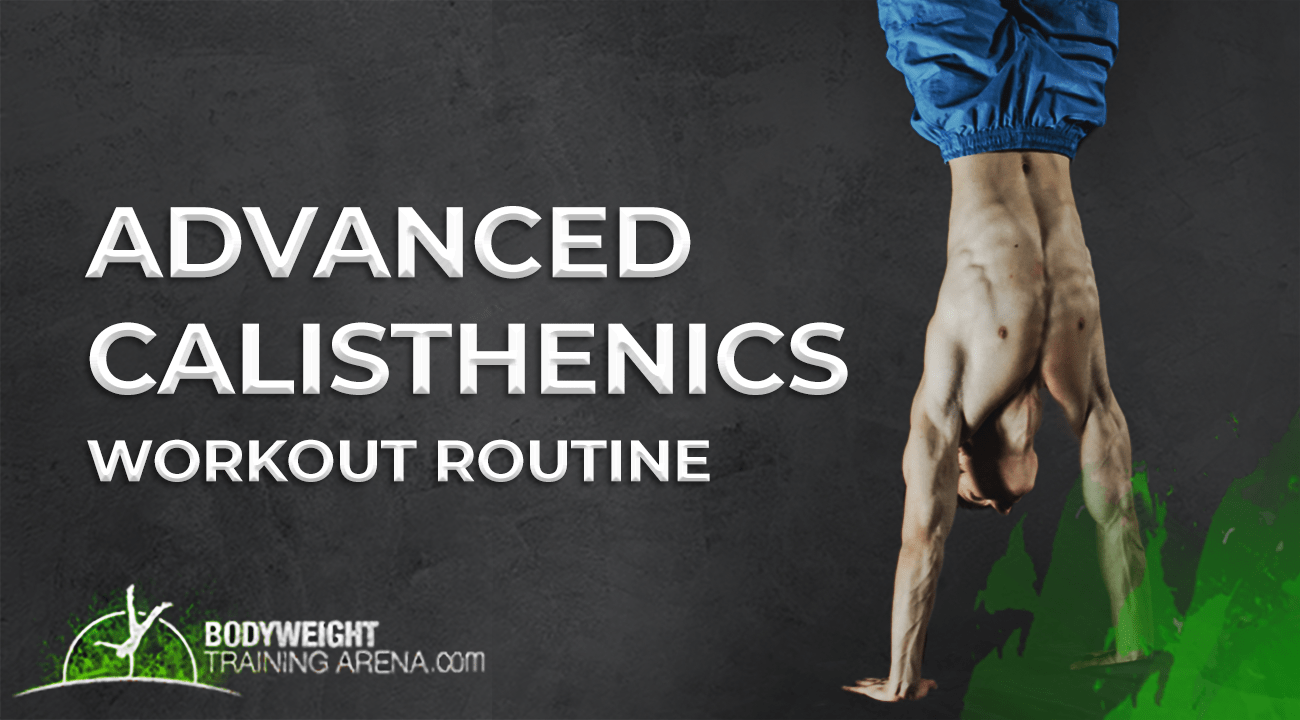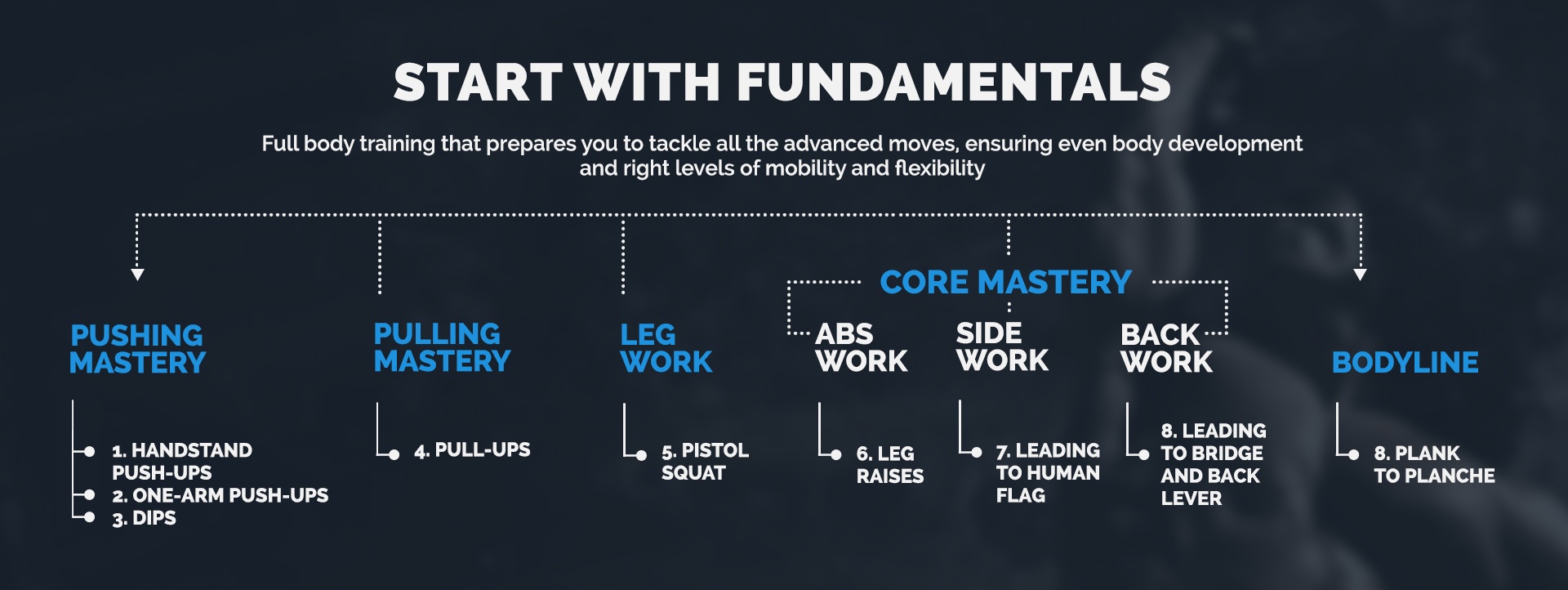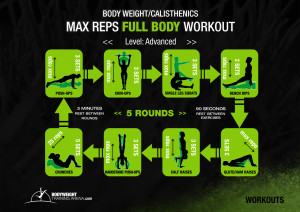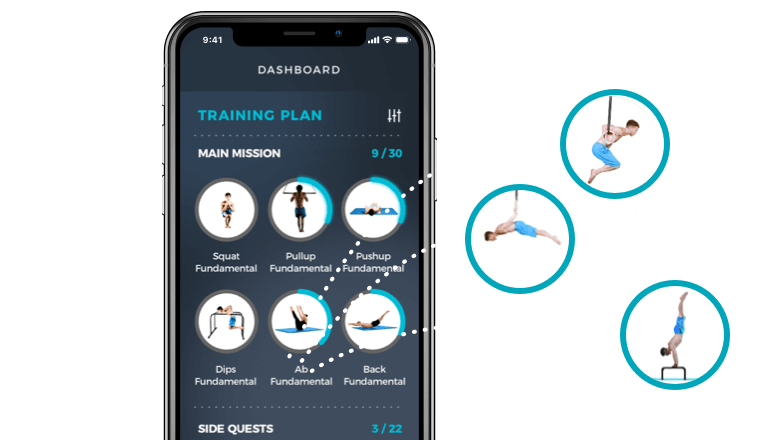
Join the tribe of Movement & Calisthenics Athlete - people just like you that are working with their own body weight to get strength, lose fat build muscle, recover from injuries and live their best lives!
Workout Routine for Advanced Calisthenics
The calisthenics world is full of exercises that push our bodies to the limits with gravity-defying skills. I didn’t even know that these advanced skills even existed until I was introduced to the calisthenics.
Yes, I’m talking about those moves which make anyone go “Wow, I wish I could do that!”. Brutal strength and muscle mass will never be enough to execute them. Pulling off advanced calisthenics moves is the ultimate test of body control. It requires strength, mobility, balance, body coordination and mind-muscle connection all at once.
How do you know if you are ready for advanced calisthenics workout routine?
First of all – they seem too hard to be executed by an average person. That’s because foundational strength and mobility aren’t enough to learn the move. Don’t get me wrong. They will help you, but advanced skills require a specific kind of strength. Later, we’ll provide you with a workout to develop the necessary strength.
The second factor is the time required to learn the skill. As I said earlier, these movements always take time to learn, unless you’re a freak of nature. Don’t expect to get a planchet or a one arm pull-up in your first or even 50th try. It will take time.

calisthenics training fundamentals
It’s really important that you master the fundamentals before trying to accomplish advanced moves.
How do you know where you are at? Take our personalized assessment here
Going back to the skill aspect – you shouldn’t just go all in and try do a press-to-handstand or front lever without prepping for it! You should learn to take the necessary steps first. We call them progressions.
Progressions are steps towards advanced skills.
To give you an idea, progressions are like adding weights in free-weight lifting. In the gym, if you want to increase the difficulty to reach your goal, you will have to add the weights slowly to avoid injury.
In progressions, we start with a move which is basic, but still trains the proper form and technique. We’ll also give you the progressions for each advanced skill. If you are keen on learning the move, don’t skip the progressions. Take your time. It’s better to follow the progression and learn it safe and easy way.
Make sure you already have good foundational strength, mobility and coordination.
I can’t stress this enough. You will only waste your time training for advanced skills if you can’t even do a properly controlled push-up. Advanced skills, even though if they target specific muscles, still make use of the entire body. Overall body development is required.
Below you can see how we organise the skill training within The Movement Athlete Platform. You take personalised assessment so we can see where are you at on the journey. You might have to start with fundamentals or you might have already unlocked advanced skills. These are just examples of skills you will be able to learn as we are constantly adding new skills. Note that fundamentals unlock intermediate and intermediate unlock advanced so its a never-ending journey of physical mastery.
What’s important though is that you don’t need to worry about what do to every day as we use advanced technology to create the most optimal home calisthenics workout for you.

calisthenics training plan
Calisthenics advanced skills progressions
Let’s look at the advanced skills and their progressions.
1. Side Plank – I think this is the easiest one in this list – but don’t underestimate this move! This type of side plank will definitely build strength and control with your obliques. But before reaching this level, you will probably take some time building up strength in the sides of your core.
a. Elbow side plank
b. Elbow side plank pulses
c. Elbow hip touch and lifts
d. Elbow side plank raises (Just to Neutral)
e. Side plank
f. Side plank (Leg lifted)
g. Side Plank Twist
2. Wall Handstand Push-up – This exercise is a handstand push up minus the element of balance but still a difficult move to perform. It primarily aims your shoulders, arms and core.
a. Incline push up v1
b. Incline pike push up
c. Incline Diamond pike push up
d. Arms bent pike holds
e. Pike push up
f. Decline pike shoulder taps
g. Decline arms bent hold
h. Pike push up leaning forwards
i. Box knee handstand push up
j. Box handstand push up
k. Wall handstand bent elbow hold
l. Handstand push up negatives wall (from top)
3. Muscle up Intro – Muscle up intro is the transition from you pull ups to your dip. Basically, it is a pull up with a higher top portion. A very challenging upper body workout that should be included in your routine.
a. Chest to bar slow descents
b. Chest to bar holds
c. Chest to bar pull ups
4. Strict Ring Muscle up – This is probably the most difficult form of the muscle ups. Muscle ups, by the way, are a combination of a pull up and a dip. Do this in a ring instead of a bar and you’ll add a stabilizer to the equation. Also, doing it on the rings adds difficulty to the hand technique. Strict means slow and controlled motion, no utilization of momentum.
a. From hang rib cage to ring pull up
b. Transitions rib cage to ring to low dip
c. Transitions leaning hang to low dip
d. Transitions leaning hang to full extension
e. Low muscle up
f. Muscle up
5. Kipping Bar Muscle up – An easier version of the form exercise. Instead of a ring, on a bar so less strain on the core and different hand technique. Use of momentum lessens the strength requirement of the exercise.
a. Hanging shoulder Kips (Bar)
b. Half Pull up tuck kick to full pull ups
c. Pull up pushaway to 3x shoulder kips (Bar)
d. Kipping pull up (Bar)
e. ¾ Pull up kick to chest to bar pull ups
f. Chest to bar pushaway to 3x shoulder kips
g. Kipping chest to bar pull ups
h. Kipping belly button to bar
i. Jumping muscle ups
j. Mini dips
k. Kipping bar muscle ups
6. Planche – Planche is my favourite advanced skill because of it’s difficulty and complete utter coolness. It is a gymnastics-based exercise that makes you look floating in mid-air. You are only supported by your arms. This exercise takes a lot of toll on your shoulders, arms, chest, core and especially the wrists, but full body contraction is still demanded including the legs!
a. Knee planche hold
b. Planche rocks
c. Wall rocks
d. Leaning plank hold
e. Pseudo planche hold
f. Box planche rocks
g. Box plank hold
h. Frog plank hold (with box)
i. Box tuck planche hold
j. Box tuck planche (1 foot)
k. Knees on forearm tuck planche
l. Box straddle to one leg tucks
m. Floor straddle to one leg tucks
n. Box straddle to tuck planche slides
o. Tuck planche hold
p. Straddle to tucks
q. Tucks to one leg extend
r. Planche hold
7. Kipping Ring Muscle up – Similar to the other kipping muscle up, this is easier because of the momentum. You’ll just have to mind your control and technique during execution. Mind you that this is more difficult compared to the bar kipping muscle up because of the unstable platform. They also work the muscles similar to the other muscle ups.
a. Hanging shoulder kip (Ring)
b. Pull up pushaway to 3x shoulder kips (Ring)
c. Kipping pull ups (Ring)
d. Kipping chest to ring pull ups
e. Transition false grip hang to low dip
f. Kipping ring muscle up
8. Back Lever – Levers are an amazing exercise for working the upper body and core as well. It is a gymnastic based movement that is usually done on the rings but can also be done on the bars. If you’re looking for a bodyweight exercise that builds your back and core, you’ve got to try this out.
a. Lying back lever with band lifts
b. Skin the car hold on bar
c. Skin the cat lifts and return (halfway)
d. Skin the cat lifts and return
e. Invert hold
f. Tuck lever to invert lifts
g. Tuck lever lifts
h. Open tuck lever to invert lifts
i. Open tuck lever lifts
j. Straddle lever hold
k. One leg lever to invert lifts
l. One leg lever lifts
m. One leg lever hold
n. Bent knee lever to invert lifts
o. Bent knee lever lifts
p. Bent knee lever hold
q. Back lever to invert lifts
r. Back lever lifts
s. Back lever hold
9. Press handstand – Also one of my favourite exercises (pardon my bias), this one requires a good hamstring strength and flexibility. Most people only think of the strength component regarding the shoulders (it’s still important though), but the key to finally getting it down without putting much load on the shoulders is by increasing pancake compression.
a. Pigeon holds
b. Push up to tuck slides
c. Push up to pike slides
d. Box wall weight shift tuck
e. Box wall weight shift straddle
f. Handstand straddle down (Wall)
g. Handstand straddle ups and downs (Wall)
h. Block wall weight shift tuck
i. Block wall weight shift straddle
j. Jumping tuck to handstand
k. Jumping straddle to handstand
l. Jumping pike to handstand
m. Jumping wall facing press
n. Standing wall press (Straddle)
o. Push ups wall press straddle
p. Standing press straddle
q. Push up press straddle
r. Seal stretch press straddle
10. Ring Dips – This exercise is a lot more difficult than doing dips on the bars. This is mainly because (again) of the unstable nature of the rings. Just keep in mind the proper form when executing the move. Even the first progression might already give you a challenge.
a. Ring support hold
b. Ring half dip
c. Ring bottom dip hold
d. Ring descent to bottom 5 second hold
e. Ring bottom to press
f. Ring dips
11. One Arm Push up – One of the popular and iconic moves, the one arm push up isn’t only for show. It does a good job building up unilateral strength and correcting muscle and strength balances in the upper body. Better do it in the correct form! A lot of people claim they can do one arm push up but they are actually so far from the proper technique. Don’t make the same mistake!
a. Wide push up
b. Deep push up
c. Decline push up
d. Diamond push up
e. Low push up hold
f. Wide arm low push up hold
g. Tiger push ups
h. Leaning forward push ups
i. Typewriter push ups
j. One arm assisted push up
k. Circular push up
l. Pseudo incline one arm push up
m. Pseudo half one arm push up
n. Incline one arm push up
o. Half one arm push up
p. One arm push up
12. Freestanding Handstand Push up – After mastering your freestanding handstand and getting good shoulder and arms strength, it’s time to move on to this awesome exercise. Be sure you’re already comfortable in your current progression before moving to the next one. The last thing you’ll want is a broken nose from face diving from a handstand.
a. Freestanding handstand hold for 10 seconds
b. Headstand tuck kick to handstand
c. Handstand straddle kick to handstand
d. Headstand pike kick to handstand
e. Handstand half push ups
f. Headstand pushes to handstand
g. Freestanding handstand push ups (Parallettes)
13. Freestanding Handstand – This is the main prerequisite of the earlier handstand push up. Handstands works mainly your shoulders, arms and core. There is a substantial strength aspect, but most people struggle with finding and maintaining their balance and proper form. Please, train your form. Seeing a banana handstand is such an eye-sore (and doesn’t translate for the latter harder variations).
a. Lying shrugs
b. Wall handstand holds
c. Shrugs against the wall
d. Sock shrugs
e. Wall shoulder touches
f. Wall straight arm touches
g. Pike walk out to long hollow hold for 10
h. Sock shrugs and hold for 10
i. Freestanding handstand hold
14. Front Lever – Opposite to the back lever, the front lever places you facing upwards. Of course, muscle groups worked also differ in their function since you are in a different position. Your core will be doing a lot of work to maintain your straight horizontal body line, and your upper body will also be grinding to keep you in form. Don’t ask me which lever is easier because it all depends on which one will you focus on first.
a. Dragon flag tuck lower down
b. Dragon flag tuck hold
c. Dragon flag straddle hold
d. Dragon flag legs together lower down
e. Dragon flag legs together hold
f. Scapula contractions
g. Vertical pulls
h. Vertical pulls and holds
i. Military pull ups
j. Military pull ups and hold
k. Vertical position hold
l. Pullup to vertical
m. Lower down tucks
n. Lower down legs extended
o. Tuck hold
p. One leg extended tuck hold
q. Lower down straddle
r. Straddle hold
s. Tuck pulls
t. Tuck to full vertical extension
u. One leg extended to full vertical extension
v. Lower down to full front lever
w. Straddle to vertical extension
x. Front lever static hold
15. One Arm Pull up – If you have an insane amount of pulling strength, try doing one arm pull ups! It looks hard, but it’s way harder than it already is. This is one of the best pull exercises that requires you also the proper technique.
a. Chin ups
b. Close chin ups
c. Assisted wide arm pull ups
d. Wide arm pull ups
e. Pull up circles
f. Dead hang one arm
g. One arm pull up hold
h. Typewriter pull up
i. One arm hand assisted pull up
j. One arm leg assisted pull up
k. One arm band assisted pull up
l. Negative one arm pull up
m. Half one arm pull up
n. One arm pull ups
16. Pistol Squat – For our lower body, we have the pistol squats. Learn them, train them and I hope to see you limping (just because of DOMS not of injury) after a good lower body workout because of this exercise.
a. Split squats
b. Bulgarian split squats
c. Weighted squats
d. Shrimp squats (Box)
e. Shrimp squats (Holding leg)
f. Single leg box squat
g. Weighted single leg box squat
h. Single leg box step ups
i. Single leg box touches
j. Half one leg squats
k. Assisted one legged squats
l. Negative pistol squats
m. Pistol squats
These progressions aren’t that complete yet. There are supplementary exercises that should also be included when training for a specific skill. your training program should include skill, strength, mobility, endurance and muscle exercises.

complete calisthenics training program
Nevertheless, you can still see the difficulty and duration when learning an advanced skill.
But do not be discouraged and overwhelmed by this list. You can surely do these advanced skills as long as you follow the progressions and train well. Another note, do not try working on too many skills at the same time. Choose 2 to 3 and focus on them first. If you can focus on a single skill, the better.
Now to help with the strength aspect, we have a workout routine that will help you develop the advanced strength needed for the advanced skills.
Try these advanced calisthenics workout routines
We prepared a few home intermediate calisthenics routines so you can try for yourself. But note that personalised approach is always better and safer.
Click on each to see the details and download workout plans.
But what if I can’t do some of these exercises?
Get a fully personalised calisthenics training routine just for you.
It’s a problem many of us face. We’re given routines – usually based on a standardized level – beginner, intermediate, advanced. The Movement Athlete used to do that too – because it’s very hard to create a personalized training for each and every person unless we spend a significant amount of time with them.
There was just one problem with this approach (actually there are a lot of problems with it) – it hindered our athletes’ progress. We’ve written extensively on the matter in the blog post, The end of beginner/intermediate/advanced – that is hurting your training.It simply explains why a lack of personalization is hurting your training.
Imagine if some of these exercises above were too hard for you. Your body will try to compensate with a poor form, movement dysfunction and possibly risk injury if it’s too challenging.
If some of these exercises were too easy they wouldn’t challenge your muscles to grow – you’d simply be wasting your time.
This is why we created The Movement Athlete Platform: to offer a fully personalized training program reflecting exactly where your level is for optimal performance.
Take the assessment to see how do you stack up on the 8 fundamental calisthenics moves.





